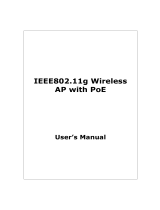
i
TableofContent
1. Introduction ................................................................................................................................. 1
1.1. Features ............................................................................................................................ 1
1.2. PackageContents ............................................................................................................. 2
1.3. SystemRequirement ........................................................................................................ 2
1.4. Applications ...................................................................................................................... 2
2. Modes .......................................................................................................................................... 5
2.1. AP ..................................................................................................................................... 5
2.2. ClientBridge ..................................................................................................................... 6
2.3. ClientRouter .................................................................................................................... 6
2.4. WDSBridge ...................................................................................................................... 6
2.5. WDSRepeater .................................................................................................................. 6
2.6. UniversalRepeater(AP) ................................................................................................... 6
3. UnderstandingtheHardware ....................................................................................................... 7
3.1. HardwareInstallation ....................................................................................................... 7
3.2. IPAddressConfiguration .................................................................................................. 7
4. WebConfiguration ....................................................................................................................... 8
4.1. System .............................................................................................................................. 8
4.1.1. OperationMode ................................................................................................... 8
4.1.2. Status .................................................................................................................... 9
4.1.3. DHCP .................................................................................................................. 10
4.1.4. Schedule ............................................................................................................. 10
4.1.5. EventLog ............................................................................................................ 11
4.1.6. Monitor .............................................................................................................. 12
4.2. Wireless .......................................................................................................................... 13
4.2.1. AP ....................................................................................................................... 13
4.2.2. ClientBridge ....................................................................................................... 23
4.2.3. ClientRouter ...................................................................................................... 27
4.2.4. WDSBridge ........................................................................................................ 30
4.2.5. WDSRepeater .................................................................................................... 33
4.2.6. UniversalRepeater(AP) ..................................................................................... 36
4.2.7. UniversalRepeater(STA) .................................................................................... 44
4.3. Network .......................................................................................................................... 47
4.3.1. Status .................................................................................................................. 47
4.3.2. LAN ..................................................................................................................... 47
4.3.3. WAN ................................................................................................................... 48
4.4. Firewall ........................................................................................................................... 49




















